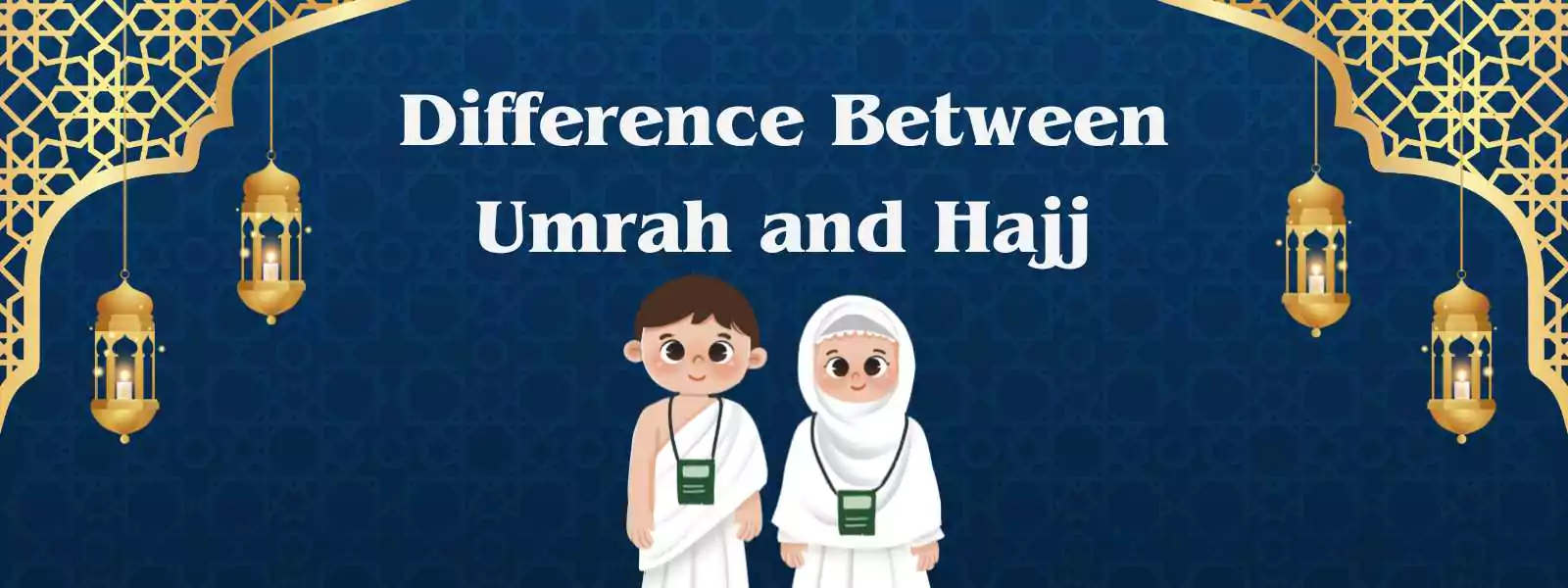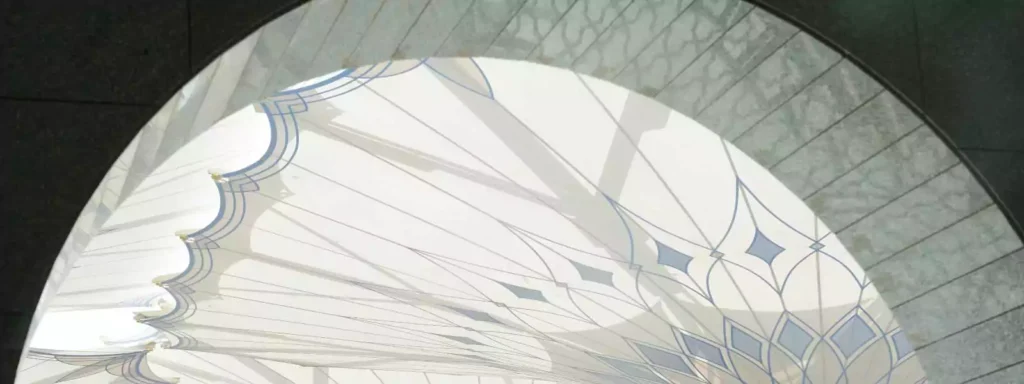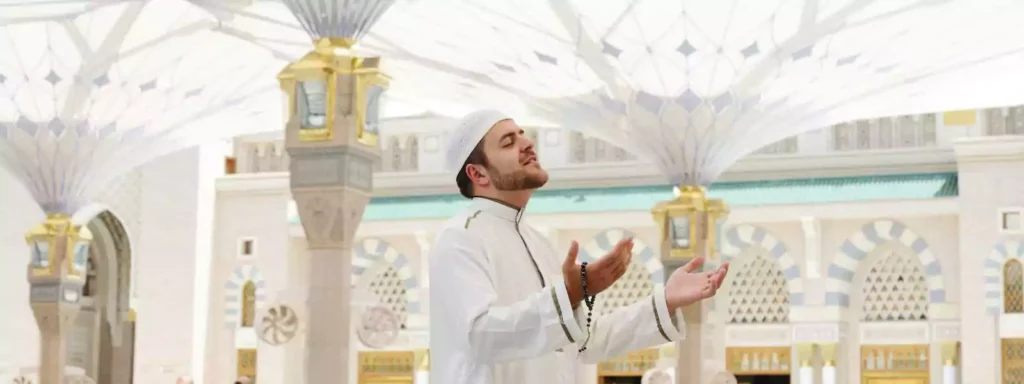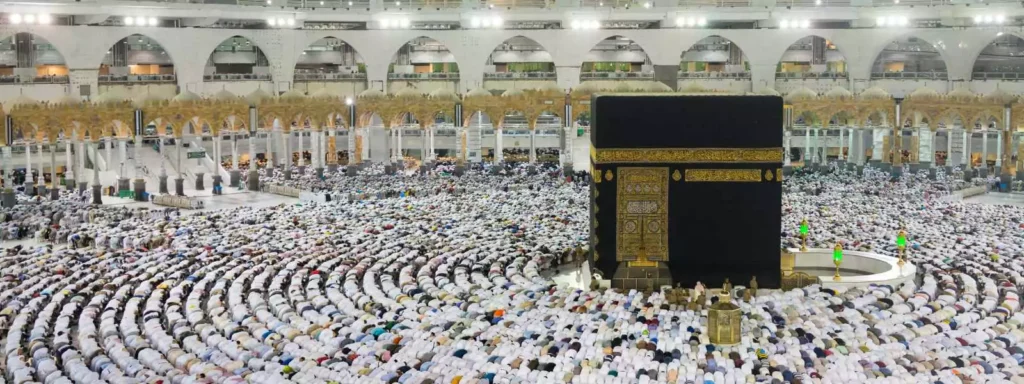
Understanding the Difference Between Umrah & Hajj A Personal Journey
Table of Contents
Introduction
When it is about Islamic journeys, two major pilgrimages are prominent: Umrah and Hajj. Imagine them as distinct colors with unique stories of spiritual journeys. I have been each of them, Umrah and Hajj I will guide your through emotional elements of each journey that makes it unique.
Umrah A Talk with the Divine

1. Is Umrah required, just as Hajj?
1. Umrah Unveiled The Quiet Invitation
Umrah is akin to receiving a whispered invitation from God. It’s not required but the nudge is too powerful to refuse. Imagine yourself in the Haram dancing through the Kaaba in the dance of devotion and feeling near the hand of Allah and feeling a connection that that words aren’t able to describe.
Umrah is an option, a voluntary practice of worship that has profound roots within Islamic culture and. “Umrah” is a term that comes from the Arabic language “Umrah” comes from Arabic which means a visit. Although it’s not a substitute for Hajj but it is a lovely gesture of dedication. In the past it was even the prophet Muhammad as well as his followers practiced Umrah which is an ancient tradition that has been passed down through generations.
2. Rituals of Umrah A Simple Dance
Rituals associated with Umrah can be described as a delicate dancing between yourself and the God of. The Tawaf The Tawaf, the Sai each step is simple, yet it is a symbol of deep significance. The act of cutting or shaving your hair can be an act of symbolic release let go of the burdens of life.
Simple acts can carry a significant significance. Tawaf which is the act of circling the Kaaba is a symbol of the continuous circle of celestial bodies which reflects the cyclical nature of life. Sai The walk in between Safa and Marwah honours Hagar’s search for water, and teaches the importance of perseverance in our journey. Shaving hair is a symbol of humility and submission and leaves the pilgrim spiritually rejuvenated.
3. Umrah's Intimate Setting: A Personal Moment
Umrah is a moment of meeting with God in a tranquil area of Mecca. The ambience is tranquil and creates a space for an intimate connection with Allah. This isn’t a huge celebration, it’s a intimate emotional conversation that sticks with the person you are with.
Mecca typically bustling, is transformed in Umrah. The energy of the day is replaced by a tranquil background, which allows pilgrims to commune with the divine in an intimate location. In the Masjid al-Haram, with the Kaaba in its heart is transformed into a place of meditation and spiritual connection.
Hajj: A Grand Unity
4. Hajj Unveiled The Important Duty
Hajj is a grand occasion, calling you to do a deed that is greater than the individual. Imagine standing on the Arafat plains of Arafat with millions of people wearing simple Ihram attire. The scream of duty echos through the air.
The earliest roots of Hajj date back to the period when Prophet Ibrahim. It is a recollection of his life and is a testimony to his an unwavering faith. Hajj is among the Five Pillars of Islam, which is a requirement for every Muslim. The appeal to Arafat as well as the stoneing of Satan in Muzdalifah and communal events at Mina are all interwoven into the history of Islamic theology and.
5. The Rituals of Hajj A Unity Symphony
Hajj is a huge tapestry of rituals that bring hearts together across the world. From the union of Mina to the stoning of Satan in Muzdalifah every act has historic significance and promises to bring unification. The pilgrimage becomes a collective journey.
It is believed that the rituals and ceremonies of Hajj are a spiritual compass. Arafat is the central point, is the symbol of the ultimate gathering at The Day of Judgment. In the midst of slaying the devil, Muzdalifah resists temptation, which is similar to Ibrahim’s determination. Mina’s collective effort Mina highlights that unity and solidarity of Muslims in the Ummah that transcends geographic and cultural borders.
6. Hajj's Global Gathering Faces of Unity
Hajj changes Mecca into a maze of faces from all corners of the world. The unity is apparent from the wealthy and the disadvantaged, from the strong to the weak everyone is alike to the Almighty. The world’s family is gathered in the vast skies.
The international flavour of Hajj makes it a beautiful pilgrimage. Muslims from all continents with different languages and from different cultures gather in Mecca. The Mecca sea of pilgrims is an enduring testimony to Islam’s universality. Islam breaking down barriers and encouraging the feeling of unity.
The Key Differences

7. Obligation and Voluntariness
The most important difference is the choice. Hajj is a obligation as well as a responsibility for those who are faith-based. Umrah is the personal choice to search for the Divine. Both pathways lead to a united heart.
Hajj’s obligation is clearly written into the foundation of Islamic faith. Umrah is, on the contrary side, is a personal decision, an act of faith motivated by a person’s desire for a spiritual connection. Each of the paths, while different, will lead to a heart that is linked to the Divine.
8. Timeframe matters A Dance of Divine Timing
Hajj takes place in a certain duration in Dhu al-Hijjah, a spiritually emotionally charged time. Umrah can be described as a dance that has amazing timing. You decide when you feel the desire to begin this journey.
It is the lunar calendar that plays a crucial part in the timing of Hajj by defining specific dates during the Islamic month of Dhu al-Hijjah. The Hajj culminates in the spectacular spectacle of thousands gathering in Mecca. Its timing is exact, and aligns with historical events that occurred in Islam’s life, including the Prophet Ibrahim. Umrah In contrast, it provides a more personal relationship with the divine timing. There’s no set month; it’s a dance of the soul and the whims of Allah and a journey that begins when the heart is at ease.
9. Ritual Complexity From Personal Ballet to Grand Symphony
Hajj is an immense symphony orchestra an empathetic collaboration of millions. Umrah is, with its simple nature, represents a unique dance, one in which every move is an expression of your own spiritual tune.
Hajj’s ceremonies last for a long time with intricate sequences and communal acts of worship. It’s a huge symphony, where individuals are an integral part of the larger. The rituals of Umrah are like a private ballet, one which unfolds according to the pace of the pilgrim. This makes for an intimate and personal connection to each act of worship.
The Emotional Resonance

In the silence of Umrah I found peace. The prayers that were whispered and the soft footsteps and the intimate conversations with Allah gave me a canvas of calm. Simpleness of ceremonies transformed into a mirror that reflected the pureness in the heart.
In Hajj’s symphony I found the unity. As I stood shoulder-to-shoulder with pilgrims from all corners of the globe and the collective beat of the Ummah resonated through my ears. The ceremonies, complex and majestic, felt like the celebration of religion and humanity.
Yes pilgrims wear Ihram simple white clothes that symbolize equality and respect in the two occasions of Umrah or Hajj.
Begin these holy travels with a heart of love and let the sound of your steps in Mecca are a melody that resonates with your soul for a lifetime. If you opt for the peaceful conversations of Umrah or take part in the symphony orchestra of Hajj Each pilgrimage marks an individual note in the wonderful melody of the spiritual path. Let your heart find peace in the arms of God and let your journey on the holy ground reflect your faith in the unwavering.
In the silence of Umrah I found peace. The prayers that were whispered and the soft footsteps and the intimate conversations with Allah gave me a canvas of calm. Simpleness of ceremonies transformed into a mirror that reflected the pureness in the heart.
In Hajj’s symphony I found the unity. As I stood shoulder-to-shoulder with pilgrims from all corners of the globe and the collective beat of the Ummah resonated through my ears. The ceremonies, complex and majestic, felt like the celebration of religion and humanity.
Conclusion Enriching Life Through Pilgrimages
In reflecting on my experiences from Umrah and Hajj and Hajj, I am able to see my soul is enriched by both of these journeys. In the intimate atmosphere of Umrah or the majestic orchestra of Hajj Each pilgrimage has left a lasting impression on my soul.
The steps in Mecca whether they are circling in the Kaaba in the quiet of Umrah or walking shoulder-to-shoulder with millions of people during Hajj are now impressions onto the surface of my personal spiritual experience. Each journey that has its own unique emotionally resonant, added to the fabric that is my religious beliefs.
Frequently Asked Questions
The answer is no, Umrah is a personal decision, a voluntary deed, whereas Hajj is a mandatory religious pilgrimage only for those who can.
Absolutely. Umrah isn’t bound to any specific date, and allows flexibility even during the holy Hajj season.
Sure, they have some common rituals, such as Tawaf or Sai but the general journey and sequence of rituals vary among Umrah as well as Hajj.
There is no limit. The heart, at any time it feels the need to follow it, is able to embark into the path of spirituality Umrah in as many instances as desired.
Yes pilgrims wear Ihram simple white clothes that symbolize equality and respect in the two occasions of Umrah or Hajj.
Begin these holy travels with a heart of love and let the sound of your steps in Mecca are a melody that resonates with your soul for a lifetime. If you opt for the peaceful conversations of Umrah or take part in the symphony orchestra of Hajj Each pilgrimage marks an individual note in the wonderful melody of the spiritual path. Let your heart find peace in the arms of God and let your journey on the holy ground reflect your faith in the unwavering.
In the silence of Umrah I found peace. The prayers that were whispered and the soft footsteps and the intimate conversations with Allah gave me a canvas of calm. Simpleness of ceremonies transformed into a mirror that reflected the pureness in the heart.
In Hajj’s symphony I found the unity. As I stood shoulder-to-shoulder with pilgrims from all corners of the globe and the collective beat of the Ummah resonated through my ears. The ceremonies, complex and majestic, felt like the celebration of religion and humanity.

